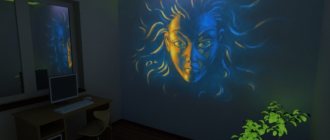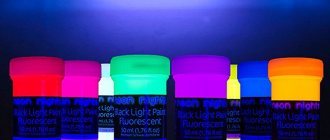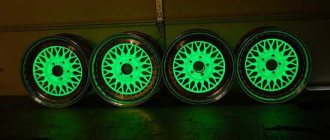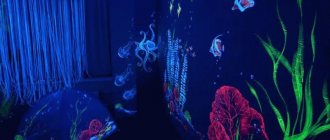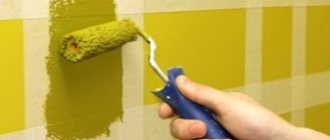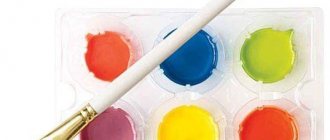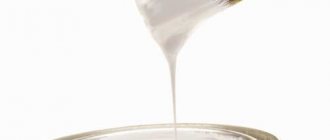How to make glowing shoelaces
If there are two options for making luminous laces.
It is worth noting that the glowing lanyard consists of a small electronic unit with a built-in LED. The latter is placed in a soft cord, which is made of silicone, and which is capable of transmitting light. The LED gets its energy from a battery.
You choose the color of the glowing laces yourself. Glowing laces operate in 3 modes. They have a switch located on the electronic unit.
* Standard lace length is 80cm.
* The laces will glow for approximately 70 hours without recharging. Next, simply replace the battery.
*Remember that luminous laces are just an accessory and therefore should not be used for tight lacing. They are not intended for specialized footwear such as running shoes or football boots (bumps).
Video lesson
Recommendations for use
In order for the coating to serve for a long time and always delight you with a fabulous glow, it must be correctly applied to the surface. All manufacturers give precise recommendations on the use of products on labels and packaging.
Preparatory work
A smooth, cleaned surface must be primed before painting.
Before painting any surface, it must be prepared:
- the wood is sanded to create a smooth surface;
- plaster, whitewash and other coatings are completely erased;
- dirt is removed with a scraper and then cleaned with a cloth or sponge with soapy water;
- greasy surfaces can be cleaned with alcohol or a solution with soda.
After removing contaminants, be sure to rinse again with plain water and allow to dry completely. Then a thin layer of acrylic primer to improve adhesion and reduce the consumption of luminescent products.
Application rules
Stir
the paint thoroughly before use , as luminous pigments may settle to the bottom. Thickened formulations can be diluted with water, adding no more than 10%. The aerosols are shaken for a long time - 2-3 minutes .
Then start applying the product:
- when using spray cans, you can use stencils and limiters;
- liquid compositions are applied to large surfaces with a roller, pouring the product into a cuvette;
- Swipe over the surface once is enough to create an even layer;
- you can use a spray gun to paint large areas;
- using a sponge to create transitions, gradients and other effects.
Among luminous compositions, phosphorescent ones consisting of phosphorus should be avoided. They can only be used where a person does not constantly come into contact with the pigment.
How to make glowing paint
The main ingredient of luminous paint made at home is the same phosphor.
You can purchase phosphor, as already mentioned, in special stores or via the Internet. It is a powdery substance that converts energy into glow.
You will need (per 1 kg of paint):
-250 gr. phosphor
-750 gr. varnish
Just mix all the ingredients.
It is worth noting that such paint will not glow as long as the one sold in stores. And don’t forget to “recharge” your paint with sunlight.
Using luminous paint, we can paint a picture in a room or paint any object. You can also put a design on a T-shirt.
What substances glow in the dark?
Objects and substances that can glow on their own in the dark always surprise and attract attention. It's so amazing that they don't require any external power source to be visible in pitch darkness. Do you remember how, when you looked at a phosphorus watch as a child, everyone dreamed of receiving the same one as a gift? Not necessarily phosphorus, of course, you can also use another substance - the main thing is that they glow. It doesn’t even have to be a watch - the main thing is that this thing glows on its own every night. Now it will be easier for us to figure out which luminous substances and objects should be taken into our home, and which ones it is better to stay away from: after all, we have prepared a whole list of substances and objects that glow in the dark. Some of them emit a fluorescent glow on their own, others - under the influence of black lamps.
This is interesting: black lamps are not lamps painted black at all, but a lamp operating in the long-wave part of the ultraviolet range. Our eyes do not perceive electromagnetic waves in this range well, so the light of a black lamp is almost invisible to us.
Radium. It is a radioactive element that emits a pale blue glow as it decays. Radium was used to create luminous paints, which were typically green in color. Marie Curie is considered the discoverer of radium. Initially, radium was considered a useful element and was actively used in industrial production: it was added to paints and food products. We can only sympathize with the regular consumers of these products: radium is extremely toxic and tends to accumulate in the body, destroying bone tissue.
Plutonium . Not all radioactive elements glow on their own. Plutonium, for example, only glows when it interacts with oxygen in the air. It produces a dark red light similar to a burning ember. Plutonium has found its main use in nuclear weapons and as fuel in nuclear power plants. By the way, during the entire testing of nuclear bombs, about 5 tons of plutonium were released into the atmosphere, which gradually dispersed throughout the world.
Phosphorus. Well-known phosphorus, like plutonium, reacts with oxygen and only after that gives off an eerie green glow. Although phosphorus glows, it is not radioactive.
Radon. Once you pump this gas into the room, you won’t even see it. But you just have to turn on the air conditioner to the minimum temperature and wait a little, and the air around you will begin to glow. At first it will turn yellow, and as it cools even more, it will turn orange-red. But it’s still better to observe this beauty from a distance - radon is a radioactive gas, which, when entering the human body, contributes to the development of lung cancer.
Actinium . Actinium is an extremely rare element. According to expert estimates, in total there are about 2,600 tons of actinium in the crust of our planet. If you still manage to collect a sufficient amount of sea anemone, you can see with the naked eye that in the dark it emits a soft blue glow.
Tritium. This radioactive element is an isotope of hydrogen. Tritium can be found in backlit watches, weapon sights, and as a power generator for autonomous sensors. Some companies even produce tritium key fobs that glow in the dark. But there is a little trick here - tritium itself does not glow, but emits electrons that fall on a special substance, the atoms of which, when excited, begin to glow. This substance is called a phosphor. For example, the keychain in the picture below works on this principle.
Tritium keychain | https://commons.wikimedia.org/wiki/File:Glowring2.jpg
But what about radioactivity? Are tritium key fobs really only suicidal people? Not at all - the energy of the electrons released by tritium is so low that it is easily retained by the protective glass and the phosphor we are familiar with.
Items and creatures.
Not only chemical elements that are rare and inaccessible to the average person can glow, but also quite ordinary things and creatures.
Mushrooms. Today, science knows about 70 species of mushrooms that glow in the dark, but there are probably many more undiscovered species in nature. Some of them glow barely noticeably, while others are visible from several tens of meters. This happens thanks to bioluminescence - the ability of living organisms to glow with the help of chemical reactions occurring inside.
Old stumps. It is no coincidence that old stumps in this list come immediately after mushrooms, because mushrooms are to blame for their glow. Rotten stumps and rotten woods are an excellent home for many types of mushrooms, among which there are no, no, and even luminous mushrooms. After some time, they occupy the entire stump, creating an absolutely incredible illusion in the dark.
Fireflies. With an ordinary bug, unremarkable during the daytime, amazing changes occur with the onset of night - the tip of its body suddenly begins to emit green light, which is formed due to the oxidation of the substance luciferin.
Can you imagine that at night this bug glows with an unusual green light?
Jellyfish. It would seem, what do fireflies and jellyfish have in common? The former live on the surface in the grass, while the latter live in the oceans at a depth of several kilometers under monstrous pressure. It turns out that both of them can glow in the dark thanks to the same substance – luciferin.
This is interesting: many sea creatures have the ability to glow. For example, plankton, which gathers in huge luminous schools. At night, such luminous clouds are visible even from space!
***
White paper .
If you are completely desperate to find anything luminous, you can open your desk and take out a simple sheet of white paper. Don't try to look at it in the dark - you won't see anything. But in this case, a black lamp will come to our aid. The white sheet contains bleaching agents that, when exposed to ultraviolet light, begin to glow bright blue. comments powered by HyperComments
Is it possible to buy such a sprout?
Planta does not intend to sell luminous tobacco; we are currently working on producing luminous varieties of traditional ornamental plants. I can’t name them all, but I will say that work is underway on roses and orchids, about a dozen varieties in total. The first luminous plant on the market will most likely be petunia; we plan to start selling them in two years.
We want to create a line of plants and occupy our niches in all segments of ornamental plants - from cut flowers to lawn grass and shrubs.
The text was prepared by Sergey Kuznetsov
Experiment 1
To begin with, I decided to just paint over the numbers with varnish and see if it was worth it or not:
And you know, I liked it.
It was decided to do everything efficiently, and to make the numbers visible on the bezel, make the surface obsolete, as in the previous review with the watch.
Constantly or not?
Plants glow all the time, continuously, but the brightness can fluctuate. They begin to glow brighter if, for example, you put a banana peel nearby. It releases ethylene, a plant hormone, which, on the one hand, inhibits plant growth, and on the other, promotes fruit ripening.
The intensity of the glow varies depending on the time of day, with peak brightness occurring approximately in the middle of the night. Young shoots glow brighter, old ones dimmer. Flowers glow brightly. And if it’s time for a leaf to die, some kind of biochemistry turns on and it flares up before dying completely.
Tatiana Mitiouchkina et al. / Nature Biotechnology, 2020
Share
The roots glow very brightly, especially their branching points. If you cut off a shoot, a new one begins to grow in this place, and this place also glows very brightly. The cut part of the plant will glow until it dries.
